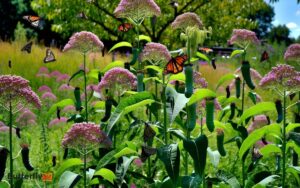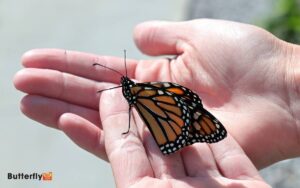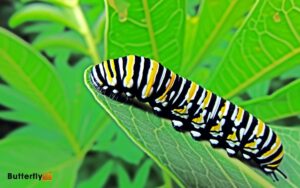Do Monarch Butterflies Eat?
Monarch butterflies (Danaus plexippus) exhibit distinct dietary requirements across life stages. Monarch caterpillars primarily consume milkweed (Asclepias spp.), which contains toxic cardenolides providing a defense mechanism via predator deterrence.
Adult monarchs rely on nectar from flowering plants such as Asclepias, Liatris, and Solidago species, which offer essential nutrients for energy and reproduction. Seasonal shifts influence their nectar sources, with an increased intake of lipid-rich nectar during autumn for migration endurance.
Maintaining diverse flora, including native milkweed and nectar-rich plants, is critical for their lifecycle and migration success. To gain deeper insights, consider exploring related ecological interactions and conservation efforts.
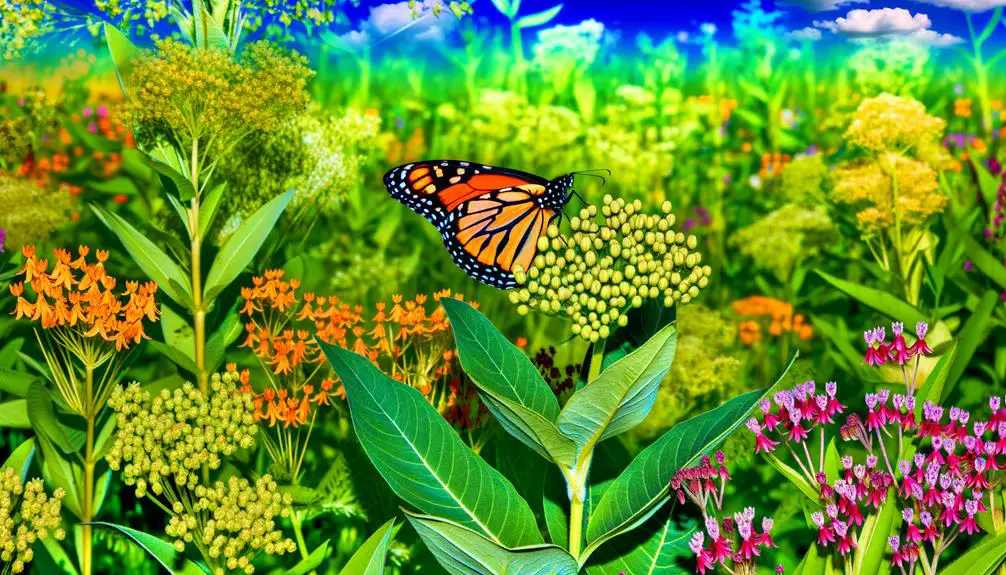
Key Takeaways
- Monarch caterpillars primarily consume milkweed leaves, which contain toxic cardenolides for defense.
- Adult monarchs feed on nectar from various flowers, including milkweed, Liatris spp., and Solidago spp.
- Monarchs prefer brightly colored, tubular flowers for efficient nectar extraction.
- During migration, monarchs shift to high lipid content nectar sources for energy storage.
Monarch Caterpillars' Diet
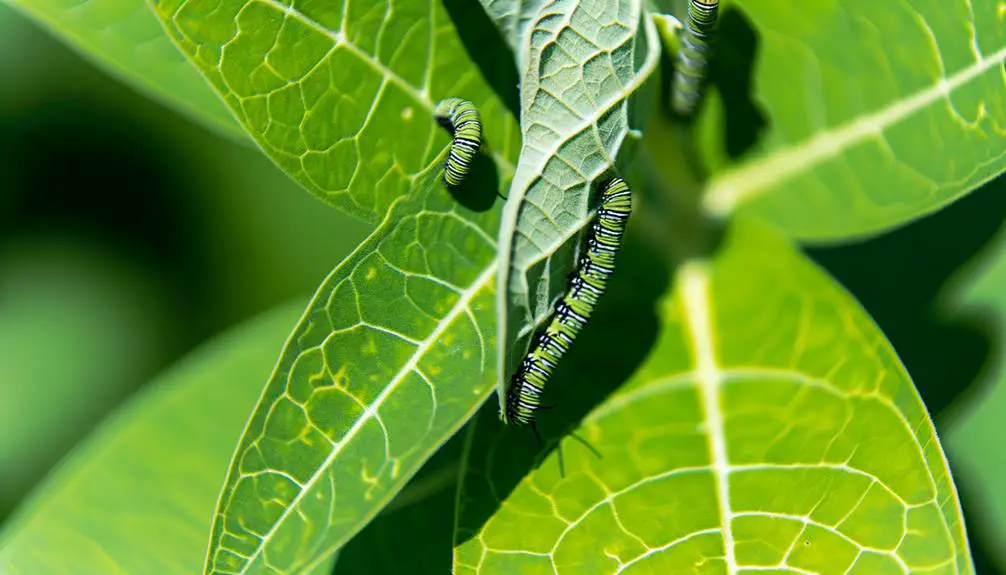
Monarch caterpillars primarily feed on milkweed (Asclepias spp.), which contains toxic cardiac glycosides that the larvae sequester for defense against predators.
Detailed observations reveal that these glycosides, also known as cardenolides, are essential for the larval stage. Studies, such as those by Malcolm and Brower (1989), demonstrate that the ingestion of these compounds makes the larvae and subsequent adult butterflies distasteful to potential predators, including birds and small mammals.
The larvae exhibit specialized adaptations, including specialized enzymes, to tolerate the toxic effects of milkweed.
In addition, the caterpillars' feeding habits are highly regulated, with a preference for younger, more tender milkweed leaves, which contain higher concentrations of cardenolides, thereby optimizing their defensive chemical sequestration strategy.
Importance of Milkweed
Milkweed (Asclepias spp.) serves as a crucial resource in the lifecycle of Danaus plexippus, providing not only the primary food source for monarch caterpillars but also the essential cardenolides significant for their chemical defense mechanisms.
The ecological importance of milkweed can be summarized as follows:
- Nutritional Value: Milkweed leaves supply the necessary nutrients for caterpillar growth and development (Agrawal, 2005).
- Chemical Defense: Cardenolides sequestered from milkweed render monarchs distasteful to potential predators (Malcolm, 1991).
- Host Plant Specificity: Monarch females exhibit oviposition preference for milkweed, ensuring larvae access to ideal food sources (Zalucki & Kitching, 1982).
- Habitat Provision: Milkweed plants support a diverse micro-ecosystem, benefiting other organisms, thereby promoting biodiversity (Borders & Lee-Mäder, 2014).
Adult Monarchs' Nectar Sources

Adult Danaus plexippus, upon emerging from their chrysalides, rely heavily on a variety of nectar-rich flowers to meet their energetic and nutritional needs essential for survival and reproduction (Brower et al., 2006).
Key nectar sources include Asclepias spp., Liatris spp., and Solidago spp., which provide a high concentration of carbohydrates necessary for sustained flight and migratory endurance (Boppré et al., 2013).
Additionally, adult monarchs exhibit a preference for brightly colored, tubular flowers, which facilitate efficient nectar extraction (Oberhauser et al., 2007).
The availability of diverse floral resources directly influences adult monarch population dynamics and migratory success (Pleasants & Oberhauser, 2012).
Consequently, conserving and restoring native flowering plants is critical for maintaining healthy monarch populations.
Seasonal Dietary Changes
As the seasons progress, the dietary preferences and requirements of Danaus plexippus adapt in response to the availability and quality of floral resources, with notable shifts observed during different stages of their migratory and reproductive cycles (Brower, 1995; Malcolm et al., 1993).
These changes are critical for sustaining their energy needs:
- Spring and Summer: During these periods, monarchs primarily consume nectar from milkweed and other flowering plants to support reproduction (Oberhauser et al., 2001).
- Autumn: As migration begins, they shift to nectar sources with high lipid content for energy storage (Brower, 1996).
- Wintering Grounds: Monarchs rely minimally on nectar, focusing on conserving energy (Urquhart, 1987).
- Late Winter to Early Spring: Increased nectar consumption occurs in preparation for northward migration (Brower et al., 2006).
Native Plants for Monarchs

Understanding the vital role that native plants play in supporting the life cycle of Danaus plexippus is essential, as these plants provide the necessary resources for feeding and reproduction throughout various stages of their development (Faldyn et al., 2018). Native milkweed species (Asclepias spp.) serve as critical host plants for monarch larvae, while adult monarchs rely on a diverse array of nectar-rich native flowers for sustenance during migration and reproduction (Agrawal, 2017). The following table lists key native plants valuable to monarchs:
| Plant Species | Monarch Life Stage Supported |
|---|---|
| Asclepias incarnata | Larval food source |
| Asclepias tuberosa | Larval food source |
| Liatris spicata | Nectar source for adults |
| Solidago spp. | Nectar source for adults |
These plants not only guarantee the monarchs' survival but also contribute to broader ecological benefits.
Creating a Monarch-Friendly Garden
To establish a monarch-friendly garden, it is imperative to incorporate essential nectar plants such as Lantana camara and Asclepias syriaca, which provide vital energy sources for adult butterflies (Baker et al., 2019).
Additionally, selecting ideal milkweed varieties, including Asclepias tuberosa and Asclepias incarnata, is important for caterpillar development (Borders & Lee-Mäder, 2014).
Strategic garden layout, emphasizing plant diversity and spatial arrangement, further enhances habitat suitability and promotes higher monarch visitation rates (Wagner et al., 2020).
Essential Nectar Plants
A diverse array of nectar-rich flowering plants is vital for sustaining the energy needs of monarch butterflies throughout their migratory journey and breeding cycles.
Monarchs rely on high-sucrose nectar sources to meet their metabolic demands. According to Oberhauser et al. (2001), the following plants are highly recommended for a monarch-friendly garden:
- Lantana camara: Known for its vibrant clusters of flowers, Lantana provides a continuous nectar source.
- Asclepias tuberosa: Commonly known as Butterfly Weed, it offers a high nectar yield.
- Buddleja davidii: The Butterfly Bush, with its elongated flower spikes, attracts numerous pollinators.
- Echinacea purpurea: Purple Coneflower, a robust perennial, serves as a vital nectar reservoir.
Incorporating these plants guarantees a sustainable habitat for monarchs, fostering their survival and migration.
Ideal Milkweed Varieties
Maintaining a monarch-friendly garden also necessitates the inclusion of specific milkweed species, which serve as the sole larval host plants for monarch caterpillars. Key varieties include Asclepias syriaca (common milkweed), Asclepias incarnata (swamp milkweed), and Asclepias tuberosa (butterfly weed).
Each species offers unique ecological benefits, such as tolerance to various soil types and moisture levels, enhancing habitat resilience (Agrawal, 2017). A. syriaca is particularly robust in well-drained soils, while A. incarnata thrives in wetter environments. A. tuberosa, with its vibrant orange flowers, supports diverse pollinators.
Incorporating these milkweed varieties can greatly bolster monarch populations, promoting both larval development and adult nectar foraging, thereby contributing to the overall biodiversity and ecological health of your garden.
Garden Layout Tips
When designing a monarch-friendly garden, strategic placement of milkweed and nectar plants is essential to maximize habitat efficiency and support the entire monarch lifecycle. Effective garden layouts consider both the spatial and temporal availability of resources.
Here are four key tips for garden layout:
- Zonation: Place milkweed (Asclepias spp.) centrally, surrounded by nectar plants like Lantana and Echinacea, ensuring easy access for all monarch stages.
- Succession Planting: Include early-, mid-, and late-season bloomers to provide continuous nectar sources throughout the migration period (Batalden et al., 2007).
- Microhabitats: Create varied microhabitats with sun and shade to cater to different developmental stages and behaviors.
- Density: Plant milkweed in dense clusters to facilitate egg-laying and increase larval survival rates (Zalucki & Kitching, 1982).
Implementing these strategies promotes a thriving monarch habitat, supporting both resident and migratory populations.
Supporting Migratory Nutrition

Supporting migratory nutrition for monarch butterflies involves ensuring access to nectar-rich flowers, which provide essential energy reserves during long-distance travel (Brower et al., 2006).
Additionally, milkweed plants (Asclepias spp.) are important not only as larval host plants but also as sources of pyrrolizidine alkaloids significant for adult butterflies' chemical defense mechanisms (Malcolm and Brower, 1989).
These factors underscore the necessity of preserving and restoring habitats replete with these botanical resources to support monarch populations throughout their migratory routes.
Nectar-Rich Flower Preferences
Monarch butterflies exhibit a marked preference for nectar-rich flowers, such as milkweed (Asclepias spp.) and blazing star (Liatris spp.), which are critical for replenishing their energy reserves during migration (Brower et al., 2006).
These preferences guarantee ideal energy intake, essential for their long migratory journey.
Key attributes of nectar-rich flowers preferred by monarchs include:
- High nectar concentration: Essential for providing sufficient caloric intake (Pleasants & Oberhauser, 2013).
- Flower morphology: Structures that facilitate easy access to nectar (Fishbein & Venable, 1996).
- Abundance and distribution: Widely available along migratory routes (Wassenaar & Hobson, 1998).
- Bloom timing: Synchronization with migratory periods to guarantee food availability (Batalden et al., 2007).
These factors collectively support monarchs' nutritional needs during migration.
Essential Milkweed Plants
In addition to nectar-rich flowers, milkweed plants (Asclepias spp.) play a pivotal role in supporting the migratory nutrition of monarch butterflies by serving as both a significant food source and a habitat for larval development.
These plants contain cardenolides, which are toxic to most predators but vital for monarch larvae (Malcolm, 1991). The ingestion of cardenolides provides a chemical defense mechanism, enhancing larval survival rates.
Additionally, milkweeds offer essential amino acids and other nutrients that are necessary for the growth and successful metamorphosis of monarch caterpillars (Agrawal et al., 2012).
Conservation efforts focusing on the proliferation of milkweed species are consequently indispensable for sustaining healthy monarch populations during their extensive migratory journeys.
Conclusion
To summarize, the dietary requirements of monarch butterflies encompass both larval and adult stages, necessitating specific plant interactions for survival.
Monarch caterpillars depend exclusively on milkweed, while adult monarchs utilize various nectar sources, displaying seasonal dietary shifts.
For instance, a study by Oberhauser et al. (2001) demonstrated that access to diverse native plant species greatly enhances monarch survival rates during migration.
Consequently, fostering monarch-friendly habitats through careful plant selection is imperative for supporting their life cycle and migratory nutrition.



